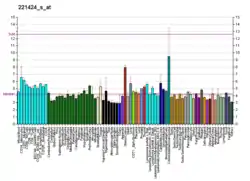OR51E2
Olfactory receptor 51E2 is a protein that in humans is encoded by the OR51E2 gene.[5][6]
Olfactory receptors interact with odorant molecules in the nose, to initiate a neuronal response that triggers the perception of a smell. The olfactory receptor proteins are members of a large family of G-protein-coupled receptors (GPCR) arising from single coding-exon genes. Olfactory receptors share a 7-transmembrane domain structure with many neurotransmitter and hormone receptors and are responsible for the recognition and G protein-mediated transduction of odorant signals. The olfactory receptor gene family is the largest in the genome. The nomenclature assigned to the olfactory receptor genes and proteins for this organism is independent of other organisms.[6]
Ligands
OR51E2 is a relatively narrowly tuned olfactory receptor, meaning it responds only to a relatively small set of related odorants.[7]
OR51E2 responds to short-chain fatty acids,[8] including in particular propionic acid.[7]
See also
References
- GRCh38: Ensembl release 89: ENSG00000167332 - Ensembl, May 2017
- GRCm38: Ensembl release 89: ENSMUSG00000043366 - Ensembl, May 2017
- "Human PubMed Reference:". National Center for Biotechnology Information, U.S. National Library of Medicine.
- "Mouse PubMed Reference:". National Center for Biotechnology Information, U.S. National Library of Medicine.
- Xu LL, Stackhouse BG, Florence K, Zhang W, Shanmugam N, Sesterhenn IA, Zou Z, Srikantan V, Augustus M, Roschke V, Carter K, McLeod DG, Moul JW, Soppett D, Srivastava S (Dec 2000). "PSGR, a novel prostate-specific gene with homology to a G protein-coupled receptor, is overexpressed in prostate cancer". Cancer Res. 60 (23): 6568–72. PMID 11118034.
- "Entrez Gene: OR51E2 olfactory receptor, family 51, subfamily E, member 2".
- Saito H, Chi Q, Zhuang H, Matsunami H, Mainland JD (March 2009). "Odor coding by a Mammalian receptor repertoire". Science Signaling. 2 (60): ra9. doi:10.1126/scisignal.2000016. PMC 2774247. PMID 19261596.
- Pluznick JL, Protzko RJ, Gevorgyan H, Peterlin Z, Sipos A, Han J, Brunet I, Wan LX, Rey F, Wang T, Firestein SJ, Yanagisawa M, Gordon JI, Eichmann A, Peti-Peterdi J, Caplan MJ (March 2013). "Olfactory receptor responding to gut microbiota-derived signals plays a role in renin secretion and blood pressure regulation". Proceedings of the National Academy of Sciences of the United States of America. 110 (11): 4410–5. doi:10.1073/pnas.1215927110. PMC 3600440. PMID 23401498.
Further reading
- Adams MD, Kerlavage AR, Fleischmann RD, et al. (1995). "Initial assessment of human gene diversity and expression patterns based upon 83 million nucleotides of cDNA sequence" (PDF). Nature. 377 (6547 Suppl): 3–174. PMID 7566098.
- Xia C, Ma W, Wang F, et al. (2001). "Identification of a prostate-specific G-protein coupled receptor in prostate cancer". Oncogene. 20 (41): 5903–7. doi:10.1038/sj.onc.1204803. PMID 11593396.
- Yuan TT, Toy P, McClary JA, et al. (2002). "Cloning and genetic characterization of an evolutionarily conserved human olfactory receptor that is differentially expressed across species". Gene. 278 (1–2): 41–51. doi:10.1016/S0378-1119(01)00709-0. PMID 11707321.
- Strausberg RL, Feingold EA, Grouse LH, et al. (2003). "Generation and initial analysis of more than 15,000 full-length human and mouse cDNA sequences". Proc. Natl. Acad. Sci. U.S.A. 99 (26): 16899–903. doi:10.1073/pnas.242603899. PMC 139241. PMID 12477932.
- Malnic B, Godfrey PA, Buck LB (2004). "The human olfactory receptor gene family". Proc. Natl. Acad. Sci. U.S.A. 101 (8): 2584–9. doi:10.1073/pnas.0307882100. PMC 356993. PMID 14983052.
- Gerhard DS, Wagner L, Feingold EA, et al. (2004). "The Status, Quality, and Expansion of the NIH Full-Length cDNA Project: The Mammalian Gene Collection (MGC)". Genome Res. 14 (10B): 2121–7. doi:10.1101/gr.2596504. PMC 528928. PMID 15489334.
- Weng J, Wang J, Cai Y, et al. (2005). "Increased expression of prostate-specific G-protein-coupled receptor in human prostate intraepithelial neoplasia and prostate cancers". Int. J. Cancer. 113 (5): 811–8. doi:10.1002/ijc.20635. PMID 15499628. S2CID 27473061.
- Weng J, Ma W, Mitchell D, et al. (2006). "Regulation of human prostate-specific G-protein coupled receptor, PSGR, by two distinct promoters and growth factors". J. Cell. Biochem. 96 (5): 1034–48. doi:10.1002/jcb.20600. PMID 16149059. S2CID 20908653.
- Xu LL, Sun C, Petrovics G, et al. (2006). "Quantitative expression profile of PSGR in prostate cancer". Prostate Cancer Prostatic Dis. 9 (1): 56–61. doi:10.1038/sj.pcan.4500836. PMID 16231015.
- Wang J, Weng J, Cai Y, et al. (2006). "The prostate-specific G-protein coupled receptors PSGR and PSGR2 are prostate cancer biomarkers that are complementary to alpha-methylacyl-CoA racemase". Prostate. 66 (8): 847–57. doi:10.1002/pros.20389. PMID 16491480. S2CID 25548828.
External links
- OR51E2+protein,+human at the US National Library of Medicine Medical Subject Headings (MeSH)
This article incorporates text from the United States National Library of Medicine, which is in the public domain.




